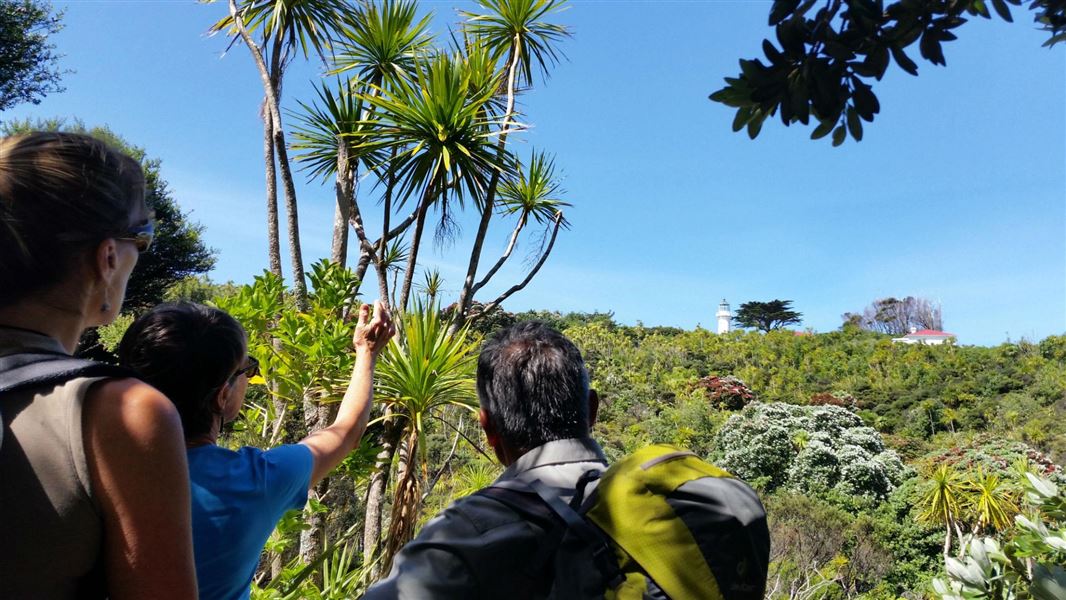Unwanted predators have been eradicated and rare native birds such as the kōkako and the takahē (once thought to be extinct) survive and thrive in restored habitats within regenerating native forest.
The island is the perfect day trip destination for nature lovers and families.
Video
Tiritiri Matangi is 4 km off the coast of Whangaparāoa Peninsula, north of Auckland.
Public ferry and charter
The public passenger ferry service by Explore Group runs 5 days a week, Wednesday to Sunday, and can get booked up well in advance during November to April. From 26 December it will be running the summer peak timetable until the third weekend of January.
Explore Group: Tiritiri Matangi
If you are chartering a commercial vessel to the island, check the operator has a Pest-Free Warrant. Commercial vessels that use the wharf will also need a wharf landing permit.
Find authorised transport operators to this island.
Private boat or kayak
Private boats and kayaks can also visit the island. The best landing is at Hobbs Beach on the western side of the island, where there is good swimming and snorkelling.
Check, clean and dry your boat and gear before visiting
Prevent pests from spreading by checking and cleaning your boat and gear after visiting a site with pests and before visiting an island.
- There is no phone available for use on the island apart from in an emergency.
- Mobile coverage is good on the grass outside the bunkhouse.
- There is no food for sale on the island.
- There is a visitor centre and shop at the top of the hill near the lighthouse. Gifts and cold drinks only are available from the shop – generally open during ferry visits.
- Toilets at wharf, Hobbs Beach, the lighthouse area and Spagetti Junction.
- Rangers live on the island and can offer further information and emergency support.
- Smoking is restricted to the concrete area at the wharf and on the gravel area behind the visitor centre.
- Keep to the tracks so you don't disturb rare plants or ground nesting birds.
- Don’t play any play back or imitation calls so you don’t disturb the birds and scientific studies.
- As a designated scientific reserve, the collection or removal of any material is strictly prohibited. This includes, but is not limited to, plant life, geological samples (rocks), and wildlife.
- Do not feed the wildlife.
Conditions of visiting Tiritiri Matangi Island
If staying at the Tiritiri Matangi island bunkhouse, you must also bring the completed biosecurity checklist.
Rules for the Hauraki Gulf Maritime Park
- Fires and portable barbeques are not allowed.
- Take your rubbish with you – there are no rubbish bins.
- No camping.
- Some activities such as weddings need a permit.
- Commercial filming needs a permit.
- Commercial guides need a permit.
These are part of the Hauraki Gulf Maritime Park by-laws. Read the full by-laws.
Tiritiri Matangi means "looking to the wind" or "wind tossing about". The island is officially called Tiritiri Matangi Scientific Reserve, and is one of the most successful conservation projects in the world.
Unwanted predators have been eradicated, and the once-pastoral island has been replanted with native trees. Rare native birds as well as tuatara and reptiles have been returned to its now-safe and restored habitats.
You can visit this open sanctuary, and see some of New Zealand's most endangered birds in the wild including takahē, kōkako, saddleback/tīeke and hihi/stitchbird.
This world renowned island sanctuary attracts more than 20,000 visitors annually.
The island is managed by DOC in partnership with Supporters of Tiritiri Matangi – a voluntary community group and major contributor to the success of Tiritiri Matangi as an open sanctuary.
 No dogs allowed
No dogs allowed
To protect our native wildlife, dogs are not allowed anywhere in this place.
Check you are pest-free
Check, clean, and seal your gear to ensure you don't bring pests, soil, and seeds.
Auckland information
| Phone: | +64 7 867 9080 |
| Email: | kauaerangavc@doc.govt.nz |
| About: | Kauaeranga Visitor Centre provides visitor information for this area |
